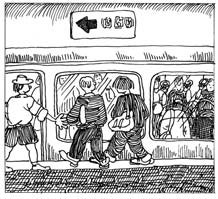Judge transit merger by its benefits
By Hong Liang (China Daily)Updated: 2007-05-15 07:06
 Many proponents of the proposed merger of Hong Kong's two
mass transit systems have been saying that such a marriage would bring great
benefits in terms of efficiency and cost savings.
Many proponents of the proposed merger of Hong Kong's two
mass transit systems have been saying that such a marriage would bring great
benefits in terms of efficiency and cost savings.
We have no doubt that this is true. The Mass Transit Railway Corporation, or MTRC, which has the monopoly to operate the subway lines in Hong Kong, is known for its management integrity and financial savvy. The wholly government-owned Kowloon-Canton Railway Corporation, KCRC, has been operating two vital lines that connect the city proper with the heavily populated suburban towns in the New Territories. Combining the two corporations seems to be the logical thing to do.
But few people in Hong Kong own shares in MTRC, a government-controlled listed company. Most people's interest in the proposed merger tends to focus on the quality of service provided by the two corporations rather than some unspecific promises of improved efficiency and cost savings.
The over-emphasis on these two factors can backfire because it raises the
prospect of serious staff layoffs. This negative side effect of the merger is
unlikely to go down well with the public when the economy is booming.
It is known that the employee organizations of the two corporations have aligned with some self-professed pro-labor politicians to seek to safeguard members' interests. Their opposition could pose a serious hurdle to the merger.
It must be realized that the MTRC-KCRC merger is a political as much as a business proposal since both entities play such an important role in the daily life of the public. Many Hong Kong opinion leaders, some of them prominent business people and professionals, seem to have missed the lesson that sound arguments which make perfect economic sense do not necessarily guarantee public support.
So, let us leave the cold economics to the accountants, valuators, and investment bankers, who are, no doubt, eminently capable of devising a strategy for the merger that will eventually prove acceptable to the government and other MTRC shareholders. It will be the task of the government and the managements of the two corporations to hammer out a new operation model that can stand the scrutiny of the business gurus in the legislature and academia.
The commuting public of Hong Kong will remain unconvinced of the merit of the proposed merger unless concrete proposals are made for improving service without raising fares or laying off a significant number of employees at each corporation. This is a reasonable demand, which is neither unrealistic nor naive.
In a typical business merger, the CEO, eager to impress shareholders, usually makes it a priority to massively cut costs by shedding less profitable units and laying off staff. These are measures that will show up most immediately on the bottom line. Such harsh measures to justify a commercial transaction are clearly inapplicable in the proposed merger between MTRC and KCRC.
The two corporations have been known to run a rather lean operation without burdening themselves with unprofitable non-core businesses. Despite the occasional hiccup, they provide services that are widely seen as satisfactory.
But there are always areas for improvement, such as more frequent service, faster and more comfortable trains, additional lines and better facilities at stations.
Any peppy business school graduate is knowledgeable enough to wield the cost cutting hatchet. It takes people with business vision, political foresight and a keen sense of public interest to make the MTRC-KCRC merger a true success.
E-mail: jamesleung@chinadaily.com.cn
(China Daily 05/15/2007 page10)
|
|
|
|